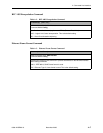
6. Diagnostics and Troubleshooting
6300-A2-GB20-10 November 2003
6-7
TraceRoute
The TraceRoute program is an IP diagnostic tool that allows you to learn the path
a packet takes from the service domain local host to its remote host.
If you are unable to ping a device in a Hotwire network configuration, you may
want to run a TraceRoute to identify the link (destinations up to 64 hops) between
the router and the device that is not forwarding the Ping message.
Table 6-4. TraceRoute Command
traceroute dest-ip [-x source-ip] [-l bytes] [-w time] [-h hops]
[-i { eth1
_dsl1 }]
Minimum Access Level: Operator
Command Mode: Standard
Performs TraceRoute to the specified destination IP address. Once TraceRoute starts, the
input prompt will not redisplay until TraceRoute finishes or is aborted with Ctrl-c.
Example: traceroute 135.300.41.8 –w 60 -i eth1
dest-ip – The destination IP address for TraceRoute.
source-ip – The source IP address used. The default source address is from the service
domain in which the test is being done. The IP address is validated to verify that it is an
interface IP address.
bytes – Bytes of data (l = length). The default is 64 bytes; the range is 0–15,000.
time – Time (in seconds) before the TraceRoute is abandoned. The default is 10 seconds;
the range is 0–60.
hops – Decimal number that specifies the maximum number of hops to be tested. The
default is 8; the range is 0–128.
interface – Specifies the target interface for the command. Do not use with the
–x source-ip selection.
eth1 – Ethernet interface
dsl1 – DSL interface


















